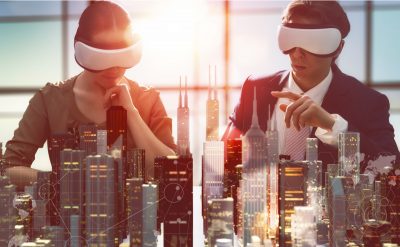Highlights
- Warehouses, production facilities, shipping companies, and retail stores rely on immersive technologies to work faster, safer, and more efficiently.
- It’s expected that the VR industry market size will reach up to USD 48.5 billion by 2025 as VR applications grow and prices continue to fall.
Since its inception in the 1950s, Virtual Reality (VR) technology has evolved tremendously. More so, in the last five years, VR technology has come a long way from being used just for video games, 3D cinema, and amusement activities. VR adoption has been possible in new applications due to the increased affordability of VR headsets and advanced innovation. The adoption of VR devices is helping organizations with product and process design, supply chain management, virtual collaboration, and experience-based learning, helping them improve efficiency, safety, and productivity.
But who knew that VR technology, which is generally associated with video games, may well revolutionize the supply chain? What started as a high-tech trend for a select few has now become a best practice for large companies as well as smaller enterprises. Warehouses, production facilities, shipping companies, and retail stores now rely on immersive technologies to work faster, safer, and more efficiently.
Right now, there is a clear growing trend among logistics and supply chain companies. The main fields of applications for VR in the supply chain are:
- Order picking in warehousing
- Predictive modeling for the internal supply chain loop
- Secure and efficient delivery
Let’s now get to know some of the value drivers of VR in the supply chain.
How supply chains can utilize VR
Supply chain management has become an essential part of many businesses owing to the age of globalization, and it helps companies achieve success and customer satisfaction. An efficient supply chain management system is a sine-qua-non for companies to succeed. Intelligent supply chain management helps improve customer service, reduce operational costs and improve the financial state of an organization. Modern supply change management encompasses the strategic alignment of end-to-end business processes to realize market and economic value and help the firm gain a competitive advantage over its business rivals.
Several factors, such as the operational needs of an organization, organizational readiness, and the alignment of technology value drivers with a company’s use cases, drive the successful adoption of VR applications in the supply chain.
- Collaborative visualization – Companies have started to leverage VR technology in their design organizations to improve CAD functionality and engineer employee engagement. What was once considered to be unavailable visualization capabilities is now accessible via VR-enhanced designs. This enables product engineers, architects, and designers to rapidly shift through multiple designs and evaluate them on the spot.
- Virtual employee collaboration – Using audio and video capabilities of VR, employees can collaborate with other colleagues around a shared virtual space or interact through virtual avatars. As VR instantly enables access to any platform worldwide, it leads to enhanced virtual collaboration through real-time simulations and immersive games. These exchanges help minimize costs and provide manufacturers and suppliers further insight into product and process development earlier in the process.
- Data capture and visualization – Leveraging interactive 3D data, VR technology is transforming the supply chain right from the stage of the development of the product to the delivery to the end consumer. 3D data visualization helps with complex decision-making and examines the impact of certain decisions on operations. VR applications and devices also help in rapid decision-making, thus addressing pressing concerns within and across organizations.
- Realistic virtual environments – This has had a great impact on human resources for supply chain organizations. Industries such as energy, and manufacturing, often find it difficult to prepare their employees for high-risk environments. VR can help train employees ans allow them to make quick decisions.
- Real-time information for merchandize in transit – There are risks concerning the loss, theft, and product tampering when merchandise is in transit. With AR markers placed on containers and packages, companies can monitor their merchandise from checkpoints until they arrive at their destination.
Thus, VR in the supply chain helps reduce loss and ensure product safety even after a long-distance journey.This is of crucial importance for many product categories, such as food, pharmaceuticals, and criticalcomponents for automobiles.
- Collects important data: VR continuously monitors and evaluates all movements, actions, and product interactions. Understanding the customer’s thought process helps identify the products they are interested in and benefit the company. As a result, the company gains unique insights and can make offers based on their interests which can turn into sales. In other words, VR has the potential to turn each experience into data for the company.
Conclusion
When applied to the supply chain, immersive technologies like VR hold the potential for fewer errors, faster order processing, and less manual input. VR technology can help improve several processes in the supply chain. Organizations must realize the potential of VR sooner than later to stay ahead of their competitors.










